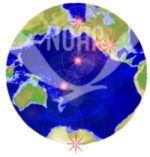 NOAA/ESRL's Global Monitoring Division (formerly CMDL)
of the National Oceanic and Atmospheric Administration,
conducts sustained observations and research related to source
and sink strengths, trends and global distributions of atmospheric
constituents that are capable of forcing change in the climate
of Earth through modification of the atmospheric radiative environment,
those that may cause depletion of the global ozone layer, and
those that affect baseline air quality.
NOAA/ESRL's Global Monitoring Division (formerly CMDL)
of the National Oceanic and Atmospheric Administration,
conducts sustained observations and research related to source
and sink strengths, trends and global distributions of atmospheric
constituents that are capable of forcing change in the climate
of Earth through modification of the atmospheric radiative environment,
those that may cause depletion of the global ozone layer, and
those that affect baseline air quality.
GMD accomplishes this mission primarily through long-term measurements of key atmospheric species at sites spanning the globe, including four fully-equipped Baseline Observatories. These key species include carbon dioxide, carbon monoxide, methane, nitrous oxide, surface and stratospheric ozone, halogenated compounds including CFC replacements, hydrocarbons, sulfur gases, aerosols, and solar and infrared radiation.
The measurements are of the highest quality and accuracy possible, and document global changes in key atmospheric species, which are all affected by mankind, identifying sources of interannual variability. In addition, research programs in key regions, utilizing an array of platforms including aircraft, balloons, ocean vessels and towers, complement the land-based information.
GMD's data are used to assess climate forcing, ozone depletion and baseline air quality, to develop and test diagnostic and predictive models, and to keep the public, policy makers, and scientists abreast of the current state of our chemical and radiative atmosphere.
GMD’s vision and mission support the broader objectives of NOAA’s Strategic Plan and are aligned with the vision and mission of the Office of Oceanic and Atmospheric Research (OAR).
NOAA Strategic Plan Elements
ESRL/GMD’s monitoring and research generally fall under the NOAA Strategic Plan Element to “Predict and Assess Decadal to Centennial Change” although much of the research at ESRL/GMD is relevant to other time scales included in the Strategic Plan. For example, interannual variations in the carbon dioxide growth rate are of major importance in studying carbon dioxide sources and sinks. Interannnual climate variations, such as those caused by the El Niño phenomenon, have an effect on sources and sinks of climatically important gases.
Objectives under the NOAA Decadal to Centennial Change Element applicable to CMDL are:
- Characterize the Forcing Agents of Climate Change
- Ensure a Long-Term Climate Record
- Guide the Rehabilitation of the Ozone Layer
- Provide the Scientific Basis for Improved Air Quality
For more information, visit our online overview , read the GMD Operating Plan, or read about GMD's research and research groups.
VISION
A laboratory that serves society by providing the best possible information on atmospheric constituents that drive climate change, stratospheric ozone depletion, and baseline air quality.
MISSION
To acquire, evaluate, and make available accurate, long- term records of atmospheric gases, aerosol particles, and solar radiation in a manner that allows the causes of change to be understood.

![[Barrow]](https://webarchive.library.unt.edu/eot2008/20090109035015im_/http://www.esrl.noaa.gov/gmd/images/brwstation_small3.jpg)
![[Trinidad Head]](https://webarchive.library.unt.edu/eot2008/20090109035015im_/http://www.esrl.noaa.gov/gmd/images/thdstation_small3.jpg)
![[Mauna Loa]](https://webarchive.library.unt.edu/eot2008/20090109035015im_/http://www.esrl.noaa.gov/gmd/images/mlostation_small3.jpg)
![[American Samoa]](https://webarchive.library.unt.edu/eot2008/20090109035015im_/http://www.esrl.noaa.gov/gmd/images/smostation_small3.jpg)
![[South Pole]](https://webarchive.library.unt.edu/eot2008/20090109035015im_/http://www.esrl.noaa.gov/gmd/images/spostation_small3.jpg)